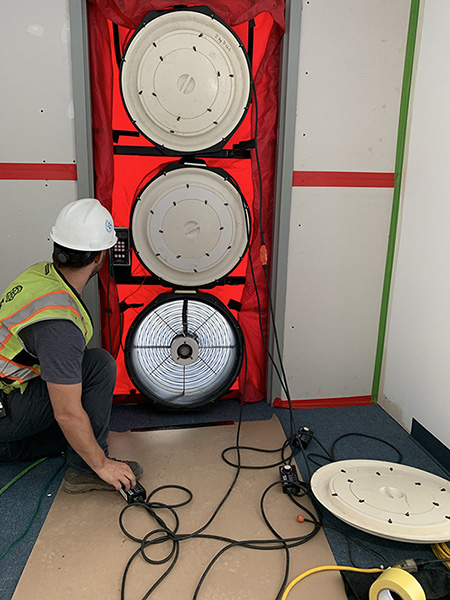Winooski School Additions Surpass Air Tightness Goals
The Winooski Schools Campus Expansion project achieved a major project milestone recently with blower door test results from the elementary and middle school additions. The test results exceed Vermont’s building energy standards and indicate an exceptionally airtight building.

Meeting High Standards
This major renovation and expansion project includes new middle school and elementary school additions, bringing the total building area to 215,000 square feet. The facility serves approximately 880 students in pre-K thru grade 12, with steady growth projected for the district.
The project set ambitious sustainability goals from the beginning and includes environmental features such as geothermal heating and cooling, 90% efficient energy recovery ventilation and a 750 kW rooftop solar array (the largest size allowed for net-metered solar systems in Vermont). But the most significant environmental feature is most likely the building envelope itself, designed to minimize heat loss through air infiltration.
To ensure that the building was designed and built to high standards, the school hired BVH Integrated Services, a Building Envelope Commissioning (BECx) agent, to work with the design team and the contractor, ReArch. The BECx agent has been a regular presence on the job site, working closely with the contractors to ensure that the design intent is executed correctly. The agent conducts regular in-place tests of joints and transitions once they are built, noting potential weak points, and working out solutions with the contractor.
Prior to completion of the Elementary and Middle School additions, the air tightness of the building was measured by a blower door test at each location. In a blower door test, a powerful fan is set into the exterior door openings to create a pressure difference between the outside and inside of the building. Air leakage is then measured in cubic feet per minute (CFM) per square foot of building surface area.
As you can see in the chart below, the blower door test results for Winooski School exceeded the requirements of Vermont’s Commercial Building Energy Standards, and nearly achieved the Passive House standard – quite a feat for any commercial or institutional building:


Why Air Tightness Matters
Buildings are responsible for about a third of all greenhouse gas emissions worldwide, which is why architects, engineers, and building owners are constantly striving to increase operating efficiency and reduce energy use. States and municipalities across the country are also enacting increasingly stringent building energy codes, including here in Vermont. To satisfy these requirements, we focus on two major areas of design: the building envelope, and the HVAC systems.
The building envelope is the term used to describe all the exterior surfaces, including roofs, walls, windows, doors, and skylights. A high-performing envelope allows for a predictable and stable environment for the HVAC systems to function within. Air tightness plays a key role. While openings at doors and windows are obvious trouble spots for air infiltration, less obvious are the numerous joints, transitions, and connections between different materials. Air leakage at these locations can quickly add up. Excessive moist air within a building’s walls and roof systems can also degrade the materials over time, driving up maintenance and repair costs. At Winooski Schools, the final building footprint will cover over 215,000 square feet with about a mile of exterior walls, making a tight building envelope critical to the success of the project’s efficiency goals.
As a result of the tight building envelope – confirmed by the recent blower door test results – and in combination with other sustainable energy strategies, the Winooski School is projected to achieve an 89% reduction in energy usage compared to the baseline of similar buildings. This will mean significant utility cost savings for the school, and a durable building that will serve the community for decades to come.